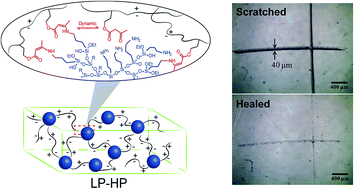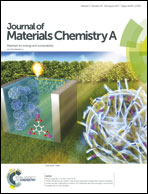Developing self-healable and antibacterial polyacrylate coatings with high mechanical strength through crosslinking by multi-amine hyperbranched polysiloxane via dynamic vinylogous urethane†
Abstract
Developing a multi-functional coating with high mechanical strength, and reversible self-healing and antibacterial ability has become an effective strategy for preventing the severe threat to human health posed by biofilm contamination. Herein, a novel linear polyacrylate resin (LP) containing pendent sulfobetaine and acetoacetyloxy groups was designed and synthesized, and was subsequently reacted with hyperbranched polysiloxane terminated by multi-amine (HPSi) to form dynamic vinylogous urethane groups. The resultant novel multi-functional crosslinked polyacrylate coating (LP-HP) shows high mechanical strength, and outstanding reversible self-healing and remarkable antibacterial ability. The concentration of HPSi in the polyacrylate coating is systematically researched and proved to play a key role in adjusting the mechanical, thermal and self-healing properties. For the polyacrylate coating (LP-HP6) containing 6.3 wt% of HPSi, its tensile strength and toughness are as high as 17.89 ± 0.42 MPa and 5.72 ± 0.32 MPa, respectively. The self-healing efficiency of LP-HP6 is higher than 92% under mild conditions (maintained at 60 °C for 24 h). This is ascribed to the unique configuration of HPSi that is rich in amine groups and has fewer chain entanglements to facilitate easier segmental motion. Furthermore, the surface of LP-HP6 exhibits high resistance to the adhesion of E. coli and S. aureus with antibacterial rates above 95%, originated from the nonspecific and nontoxic sulfobetaine groups immobilized in the main chain via convenient copolymerization. These excellent properties demonstrate that LP-HP coatings have great potential applications to resist biofilm contamination in architectural ornament, medical engineering, food and pharmaceutical fields.



 Please wait while we load your content...
Please wait while we load your content...